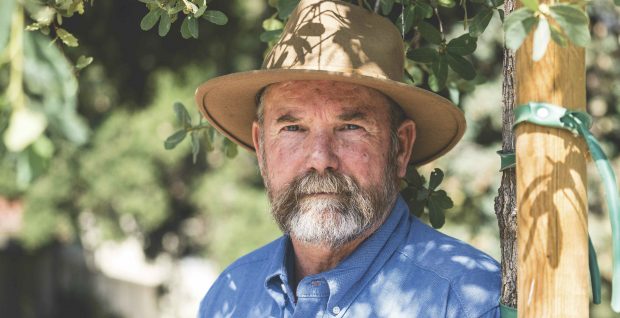
The mesa oak, with its bluish-green leaves and majestic stature, was almost completely wiped out from the landscape of Claremont and surrounding areas more than a century ago. Now Pomona’s bringing this endangered native tree back to campus, thanks to the work of veteran groundskeeper Kevin Quanstrom.
Since 2006, crews have planted about 30 mesa oak trees, also known as the Engelmann or Pasadena oak, in and around the College. Quanstrom, assistant director of grounds and housekeeping, says adding the mesa to the campus’ much larger number—in the hundreds—of coast live oaks helps diversify and strengthen Pomona’s tree population.
More than the bluish leaf color sets the mesa oaks apart: These trees are less susceptible to sudden oak death caused by pests and disease brought on by the ongoing drought, which took its toll on some of the older coast live oak trees that once lined Bonita Avenue. Quanstrom and his team had to remove those damaged trees when the roadway was rebuilt a few years ago, replacing them with the mesa.
“It’s important to understand native plants and to put native plants where you can,” says Quanstrom, who has worked at Pomona since 2004. “When going from nonnative to native plants, you’re always going to save water because native plants tend to be dormant in the summertime. People should care—these trees were part of the ecosystem before we got here, and once the trees are more established, they will help save water.”
With new developments across campus, Quanstrom took advantage of the opportunities to lay down the mesa oak around the Studio Art Hall and Sontag Greek Theatre, along Columbia Avenue and on the east side of Oldenborg Center.
Quanstrom has extensive experience with native habitat restoration, and although the tree is not readily found at local nurseries or big-name home improvement stores, he tracked down a grower in Riverside who could provide them.
Though always outnumbered by the more prolific coast live oaks, mesa oaks were most plentiful up to the mid-19th century, thriving in an area running from Pasadena as far south as Baja California. Then numbers dwindled as a result of logging. “It was very popular for lumber because it’s a very straight oak tree,” says Quanstrom.
At the same time, settlers began to fill the area and citrus trees replaced native vegetation, says Environmental Analysis Professor Char Miller, who notes that the mesa was a key timber used to shore up the new houses and buildings.
“My bet is that some of the College’s earliest buildings may have contained lumber milled from this local tree. The mesa oak largely disappeared from its historic sites by the early 20th century, and its loss is one of the reasons my wife and I planted one in our backyard, a small reclaiming of this area’s environmental past.”
Back on campus, the oak plantings are part of a larger effort to introduce drought-tolerant plants, but Miller finds the return of the majestic trees to be a particular point of pride. “This restoration project is a marker of the College’s sustainability commitments and our willingness to invest in making the grounds less thirsty, more resilient,” he says.
